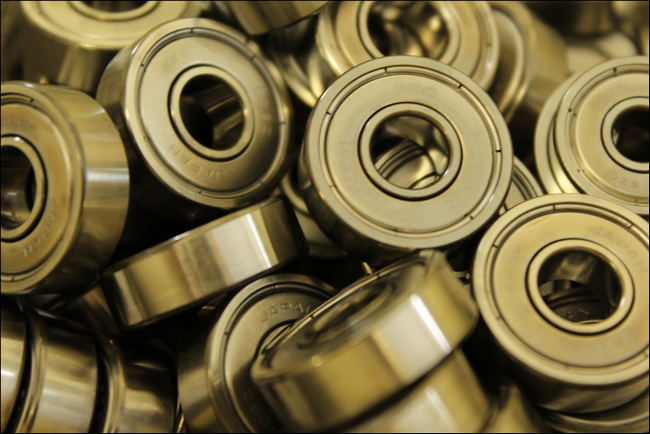Displaying items by tag: smb
Energy efficient bearing design
~ Three bearing design considerations to reduce friction ~
It is estimated that a ten per cent reduction of friction in all large bearings in use would provide an energy saving equal to the output of 18 large power stations. Cutting friction in bearings of any size is a key method to improve energy efficiency. Here Chris Johnson, managing director at miniature bearings supplier SMB Bearings explores the bearing design possibilities for increased efficiency in industrial applications.
In recent years, bearing manufacturers have increasingly focused on creating energy-efficient bearings — making use of new materials, lubrication techniques and advanced geometry designs to reduce losses without sacrificing the load carrying capacity.
However, energy losses in bearings are not considered the primary focus of plant optimisation efforts because they are already considered a high efficiency component. On the other hand, some argue that bearings are so ubiquitous — with a huge number of installed bearings in industry — that this overall energy consumption and potential energy savings should not be ignored. Let’s take a closer look at three bearing design considerations to decrease friction and increase efficiency.
Advanced materials
Energy-efficient bearing designs focus primarily on reducing the contact between the rolling elements and the raceways or the cage. By reducing the roughness of the contacting elements, friction will be reduced. Furthermore, the osculation of the bearing at both the inner and at outer rings significantly effects the friction by reducing the contact area and thus the microsliding of the contact.
According to a 2021 study, friction-optimised designs can have a significant impact on the reduction of the global energy losses of bearings. Based on the design of one bearing manufacturer, a preliminary estimation of this reduction is about 0.15 – 0.20 per cent of global energy consumption.

Traditionally, steel has been the material of choice in bearing design, but polymer-based materials, such as PTFE and nylon, offer many benefits when used in less demanding environments. These benefits include corrosion resistance, reduced need for lubrication and a reduced weight.
Geometry
Geometry considerations such as special cage designs and the number of balls in a bearing influences the amount of friction generated, as this determines the number of frictional contacts during operation. The geometry, as well as the process by which the retainer is manufactured, have an influence on the friction generated. For example, opting for a 3D printed retainer in nylon (PA66) or another polymer material can help to reduce the weight of the whole bearing.
In some cases, ceramics offer a feasible alternative to metal. They have properties that offer similar benefits to metal, but they’re much lighter too.
Carbon-fibre reinforced nylon is one of the most popular combinations for nylon-printed materials. It offers many of the same benefits as standard nylon including high strength and stiffness, but it produces significantly lighter components. Surface coatings can have a significant effect on bearing friction reduction. Coatings such as molybdenum disulphide and tungsten disulphide increase wear resistance, fatigue durability, and reduce friction during bearing motion.
Lubrication
A proper lubricant will reduce friction between the internal sliding surfaces of the bearing’s components and reduce or prevent metal-to-metal contact of the rolling elements within their raceways. While this is a good way of reducing wear and preventing corrosion, there are new materials that, when used on bearings, dramatically reduce friction compared to the lubrication and surface treatment options that are currently on the market. The material in question is graphene.
The process of adding a graphene coating to bearings would be relatively simple and similar to adding a traditional lubricant. When graphene becomes readily available, we will examine this form of lubrication more closely.
As well as not being harmful to the environment, graphene flakes that are added to the surface of a bearing can last a considerable amount of time, due to the ability of the flakes to reorient themselves during the initial wear cycles, providing a very low coefficient of friction (COF).
In a study on the potential of graphene as a new emerging lubricant, researchers estimated that the reduced loss of energy to friction offered by new materials would yield potential energy savings of 2.46 billion kilowatt-hours per year, equivalent to 1.5 million barrels of oil.
By optimising each element of a bearing’s design to consider friction, it is possible to reduce bearing friction. By multiplying this saving for each bearing in a machine, plant or industry, significant energy savings can be realised.
For further information about SMB Bearings’ range of products and services visit the website
About SMB Bearings:
SMB Bearings originally specialised in miniature bearings, thin-section bearings and stainless steel bearings. By natural progression, the company expanded the range to include other corrosion resistant bearings such as plastic bearings, 316 stainless bearings and ceramic bearings.
Remaining a specialist business, SMB Bearings provide a high level of product knowledge, providing bearing and lubrication solutions to existing or potential customers, whether individuals or large corporations. SMB Bearings does not just sell bearings, but helps to solve your problems.
For further information please visit http://www.smbbearings.com/
Bearings can help the environment
~ How chrome steel can fight the beast of climate change ~
Reducing your carbon footprint is like a marathon: dedication and discipline will only get you so far. To get first place, you will need to be efficient in every step you take. Similarly, businesses must strive to be efficient to meet tighter goals to reduce CO2 emissions. Here, Chris Johnson, managing director of SMB Bearings, explains how industry can use advanced chrome bearings to go green and, at the same time, reduce electricity consumption.
According to the International Energy Agency (IEA), around 30 per cent of global electricity is consumed by electric motors in industry. Furthermore, motors are the asset that consume the most electricity in manufacturing, accounting for 70 per cent of global electricity in the industry. From this, we can calculate that a 0.1 per cent reduction in industry consumption could save enough electricity to sustain the UK for almost a month.
ABB Group has found, using IEA data, that 51 per cent of all motor failures are related to their bearings. The common causes for these failures include exceeding recommended load ratings, vibrations and overheating. Choosing the right bearing for a motor can not only reduce the chance of failures; it can also bring down a business’s emissions and maintenance costs.

No universal fit
There is no one-size-fits-all for bearings. AISI-440 grade stainless steel small motor bearings can sustain temperatures of up to 300 degrees Celsius, which makes them ideal for machinery that operates under high heat. However, the same process that allows the stainless steel to obtain these properties will also soften the metal. This makes the internal components more susceptible to physical damage.
Chrome steel small motor bearings are not only less expensive, but are also better suited for most applications. They have low-noise and low-vibration properties that make them less wasteful in applications below 150 degrees Celsius. While some situations may require the superior anti-corrosion properties of stainless steel, most industries will benefit from the more efficient chrome steel alternative.
Vibration and noise can also be caused by exceeding the recommended payloads of a motor. Fortunately, chrome steel has 20 per cent higher load rating than 440C grade stainless steels so these symptoms of failure are less likely to occur. Higher load ratings are also associated with longer life cycles, and therefore lower maintenance costs.
Win-win scenario
Choosing chrome steel bearings is not only likely to be more effective than 440C stainless steels, but also less expensive in the short and long term. The energy converted in noise and vibration is lost, resulting in further wasted time and energy for downtime and motor repairs.
Electricity wasted on poorly-matched motors and bearings can prevent your company from being as environmentally-friendly as it could be. That’s why selecting a bearing that can sustain the loads it is subjected to, can drastically increase the product’s lifetime while reducing the energy that is thrown away. In the long run, we will need to be as efficient as possible about energy consumption.
Just like in marathons, dedication and effort alone will not get you the best time. Efficiency is key, which also applies if businesses are to help save the climate and also reduce costs. If you’d like to be a leader in industry by reducing your carbon footprint, while making the best of your machinery, then get in touch with SMB Bearings at https://www.smbbearings.com.
About SMB Bearings: SMB Bearings originally specialised in miniature bearings, thin-section bearings and stainless steel bearings. By natural progression, the company expanded the range to include other corrosion resistant bearings such as plastic bearings, 316 stainless bearings and ceramic bearings.
Remaining a specialist business, SMB Bearings provide a high level of product knowledge, providing bearing and lubrication solutions to existing or potential customers, whether individuals or large corporations. SMB Bearings does not just sell bearings, but helps to solve your problems.
For further information please visit http://www.smbbearings.com
